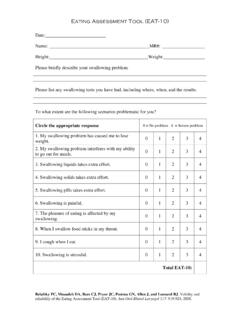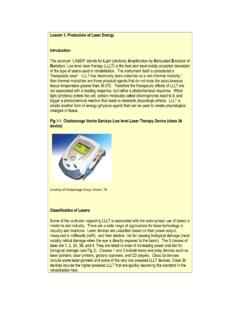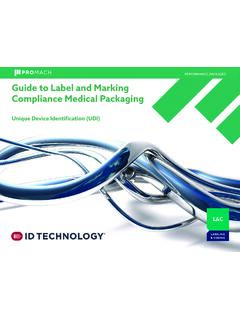Transcription of FAQs (Frequently Asked Questions) - DJO Global
1 Date: September 22, 2016 To: All DJO Global Customers Subject: UDI is Here! By December 1, 2016 Customers should be ready to accept NEW UPC barcodes Effective September 24, 2016 the FDA is requiring that all United States FDA Class II medical device labels include Unique Device Identifiers (UDI) with the goal of adequately identifying devices through their distribution and use. To comply with the new UDI assignments, DJO Global must change the Universal Product Code (UPC) barcodes on all Class II products to align with the GTIN (the device identifier included in the UDI GTIN stands for Global trade Item number ) & replacing the HIBCC barcodes on the majority of our products. Answers to questions you may have regarding these changes may be found on the DJO website, in the FAQs below, or by contacting: FAQs (Frequently Asked Questions) Q: How will UDI impact hospitals or clinics?
2 A: If hospitals or clinics do not use/scan the barcodes today to dispense stock, transact and/or bill for product, this change will have little or no effect on your business. If you scan barcodes today to dispense stock, transact and/or bill product, please ensure your software/system is updated with the new GTIN/UPC barcodes that are available on the DJO website. Q: What barcodes have been included on DJO labels historically? A: There could be several and it depends upon the type of product packaging and how product is typically dispensed. 1. HIBCC This barcode includes the Labeler Identification number and part number . Most medical facilities do not use this barcode today, however if you do utilize this barcode today for dispensing, stocking, transacting or billing product, please ensure they have list of new GTIN assignments (the 14-digit code that follows the identifier (01) in the human-readable portion of the barcode).
3 2. UPC This barcode is utilized primarily for retail packaged product sold in a retail/consumer setting. Q: Where can I find out more about the recent UDI changes? A: Click on any of the hyperlinks below for more information. CDRH Learn Reference Unique Device Identification (UDI) System Section FDA Information Page on Global UDI Database GS1 Unique Device Identification (GS1 is our GTIN provider) UPC and GTIN Alignment Reference Data Structure / Date Storage Examples Section Q: What Class II products are affected by this UPC barcode change? A: See the listing of products on the brand pages on the DJO website. Products include: Compression Hosiery; TheraTherm hot therapy; and Muscle Stim within the Brands: Aircast, Bell-Horn, Chattanooga, Compex, DonJoy, & Shape-to-Fit. Q: What are Class II products? A: Medical devices sold in the United States are classified into Classes to identify the level of regulatory controls required for the products, which range from the highest regulatory control (Class III, which came under UDI compliance in 2014), to Class I devices, requiring the least regulatory controls.
4 Class II devices are in the middle and fall under the UDI compliance deadline of September 24, 2016. Examples of Class II devices include electrodes and hosiery, which make specific health claims. Q: Does the UDI change affect or change products that have Serial numbers? A: No, the Serial numbers are not impacted and will not change. Q: If the Wholesaler provides pharmacies/retailers product with old UPC labels, is the pharmacy/retailer required to affix a new UPC barcode to be compliant with UDI? A: No. Retailers would not be required to update labeling for those items, however, if the pharmacy requires the new UPC to transact and/or bill for product, the pharmacy can request new UPC labels from DJO. Send request to: Q: How do I order new UPC labels for effected products in my inventory? A: Send a request to with the product number (s) and quantity of UPC labels required for each product, plus the name & address for shipping the UPC labels (via UPS).
5 Q: Why is DJO changing the UPC number and not aligning their current UPC number to the GTIN? A: DJO newly assigned GTINs to all DJO products to include products that do not bear a UPC today. This internal change necessitated the update of UPCs to align with the new GTIN assignments. The standards DJO follows for bar coding products requires the GTIN to align with other GS1 barcodes, such as UPC, present on a label. Q: If I have stock of product with old UPC labels in my distribution center/office after the December 1, 2016 cut-over date, how do I transact? A: You may request new UPC barcode labels from DJO by providing the part number and quantity needed. DJO will ship the new UPC labels to you to place on the product boxes. Send request to: Q: How long will I be able to utilize the old UPC barcode for transactions? A: You can continue to use the old UPC until you transition your systems to accept the new UPC barcodes Please note, customers MUST transition by December 1, 2016 as DJO will no longer dual label product with both the old and new UPC.
6 Q: What about product currently in DJO distribution warehouses, have the products been labeled with new UPC barcodes? A: DJO will cycle through product with old UPC barcodes and all newly produced product will carry BOTH old and new UPC labels (Dual labels on each product) to allow customers to transact inventory. Therefore, it is recommended customers update their systems on or close to December 1st. Q: What if I have already updated my system for the new UPC barcode and I receive product with the old UPC labels? A: You may request new UPC barcode labels from DJO by providing the part number and quantity needed. DJO will ship the new UPC labels to you to place on the product boxes. Send request to: As of December 1, 2016 Customers should be ready to accept NEW UPC only As of December 1, 2016 all remaining stock in DJO Distribution Centers will be labeled with new UPC barcode labels.
7 Product carrying dual labels will cycle through inventory until exhausted. For Questions pertaining to UDI/UPC/HIBCC changes contact the DJO Global Regulatory team at: Thank you for your support during this transition. Sincerely, Ghazi Kashmolah Sr. Vice President, Global Quality and Regulatory














